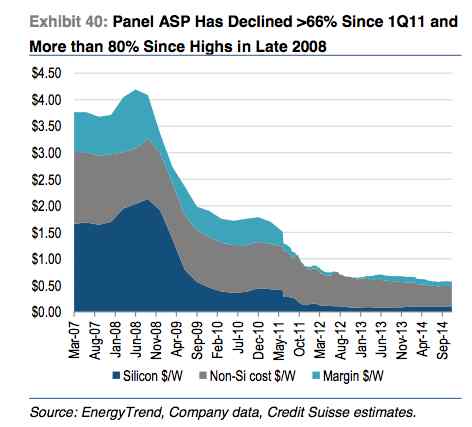Solar cell technology developed by Australia’s world leading University of NSW solar research team is likely to become the standard for global manufacturers within 5 yers, ushering in new dramatic falls in the cost of solar technology.
Professor Martin Green, the head of the UNSW solar research team, says the PERC technology developed by UNSW was likely to become standard in more than half of all solar cell production across the globe by 2020.
This, Green says, will help accelerate the push to greater efficiency (as the standard moves from near 20 per cent to beyond 25 per cent), and in turn helping to continue the remarkably rapid fall in solar costs over the last 5 years.
PERC stands for Passivated Emitter and Rear Cell. Essentially it is a technique that ensures that solar rays, which were once absorbed into the module, are instead reflected back to the rear of the solar cell, so ensuring that its efficiency is increased.
Researchers have been working on this for several decades, but the technique developed by UNSW is easily applicable to global manufacturing operations. Already, PERC is used in 10 per cent of global capacity. By 2020, it will be used in more than half of all solar cell production, Green says. (See graph below, PERC is in red).
“There is no doubt about the future,” Green told a NSW-government sponsored “Solar Breakfast event in Sydney on Monday, outlining the opportunities for solar investment in the state. “We are in the throes of an energy revolution.”
Green pointed to the recent prices of $US40/MWh obtained in a major capacity auction by the City of Austin, Texas. As the local utility noted, prices would likely soon fall to around $20/MWh.
“Once you get down to those prices, very few technologies can compete,” Green said, adding that the revolution would be much quicker than most anticipated (and used some picture of the transformation in New York from the horse and buggy to the car in little more than a decade).
Green said the development and the research efforts of UNSW and other local institutions underline how Australian was one of four countries that helped create the global solar boom.
He noted that Germany had created the steady policies and markets for solar that caused the initial manufacturing boom; China had provide the low cost labour and manufacturing capacity, and “speed of movement” to bring costs down; US had provided the huge licks of finance (in its equity markets and financing models), and Australia had provided not just innovative technology, but many of the expertise, founders and chief technology officers of the first big global solar manufacturers.
He pointed to this graph above from a Credit Suisse report earlier this year, showing the falling costs of solar. The dark blue line part is the cost of silicon, the grey line represent the cost of production, and the blue line the price of sales (or the profit margin). After a tough period in 2011-13, margins were now returning, even when consumer prices were still falling.
Green writes in a paper submitted last week that the PERC technology has underpinned many of the cell efficiency record claimed in by global manufacturers in recent years, including those by Suntech, Schott, Q-Cells, and Trina.
This is one of the reasons why PERC is being adopted in manufacturing lines that are being expanded and modernised. In China, the government is effectively closing down manufacturers without access to good technologyby imposing cell efficiency standards.
“Nothing is as powerful as an idea whose time has come,” Green writes.
Green says that in mid-2015, the best performing near-commercial PERC multicrystalline cells have efficiencies in the 20 – 21% range, while the best PERC monocrystalline cells have slightly higher values in the 21 – 22% range.
Now that they are in production, widespread adoption should pave the way to 25 per cent efficiencies.
ERC uptake is likely to lead to an era of accelerated silicon solar cell performance increase as the full capabilities of this technology are exploited. Just as commercial solar cell efficiencies have approached the performance of the best laboratory Al-BSF solar cells, it is anticipated that the PERC technology will also approach that of the best laboratory cells with efficiency of 25 per cent through a process of on-going incremental improvements.












